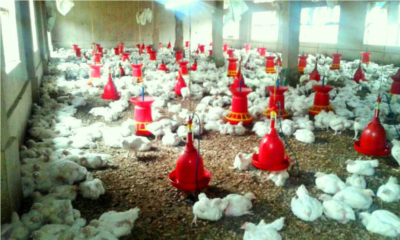
Deep litter system of poultry farming


This is the most common and popular modern system of keeping commercial poultry. Birds are confined in a house on litter of about 20cm deep which has to absorb moisture from the droppings. Materials used for litter are coffee husks, woods and having chopped straw and rice husks.
Litter is turned frequently to mix it with droppings thoroughly and more materials added.
Advantages of deep litter system of poultry farming
- It requires a small area of land to raise large number of birds.
- It’s easy to control birds since they are confined in one place
- Birds are protected from predators and thieves.
- It gives comfort to both attendant and the birds since there is little wastage energy and time in feeding and collection of eggs.
- Manure obtained under this system is of high quality
- Records of stock and egg production are easy to keep under this system.
- It’s easy to observe sick birds in the flock hence easy to cull out such birds.
- Spread of disease from the neighborhood is easily controlled since birds are confirmed.
Disadvantages of deep litter system of poultry farming
- The system encourages the buildup of parasites in the litter unless turned, treated and replaced regularly.
- It may require more labor in terms of feeding and collection of eggs as compared to the free range system.
- It’s difficult to control diseases in case of an outbreak within the deep litter house.
- Birds easily develop vices more especially due to overcrowding within the deep litter house.
- It’s difficult to keep individual production records.
- It’s expensive to establish since money is needed for the construction of houses and purchase of the necessary equipment.
- Feeders, water container, and nesting boxes are easily contaminated with litter and droppings which may lead to disease.
- Comfortable litter in poultry house may induce birds to go broody.
Management of layers in a deep litter house
- Provide enough space in the house to control overcrowding that result into vices and disease outbreak
- Keep the litter dry by continuous raking and removal of wet spots to control dampness that encourages disease outbreak
- Provide enough perches for the birds and they should be well spaced
- Provide enough water and feed troughs to reduce overcrowding at the feeding and drinking place which increase feed and water contamination
- Provide clean drinking water at all times for proper bird health and high production
- Keep feeders and drinkers clean to reduce disease outbreaks due unhygienic conditions
- Provide adequate feeds to birds to maintain a high production level
- Collect the eggs regularly to reduce chances of breaking and occurrence of egg eating vice
- Supply grit in feeds to help birds to digest grains in the feeds provided
- Cull poor layers and diseased birds to reduce wastage of feeds and disease spread in poultry
- Vaccinate birds against killer diseases in time to reduce losses
- Spray birds with pesticides to control external parasites like mites and ticks that may lower production
- Avoid stressing factors that may affect bird production
- Repair equipment and house to reduce accidents
- Provide enough feeds to ensure high production from birds
- Isolate and treat sick birds to reduce disease spread in poultry
- Keep proper records for easy management of poultry
- Promptly dispose of dead birds by burying or burning to reduce disease spread and vices
- Maintain a disinfectant at the door for anybody entering the poultry house to disinfect him.
Please leave a comment in the comment box
Dr. Bbosa Science
CATEGORIES General
TAGS Dr. Bbosa Science
